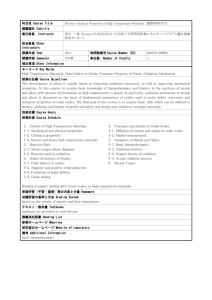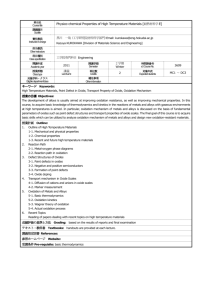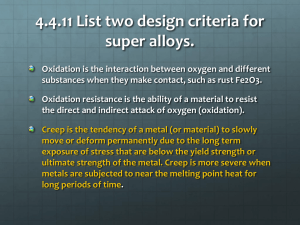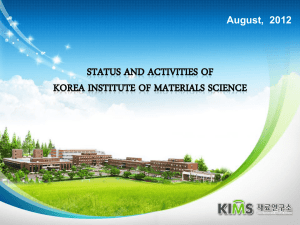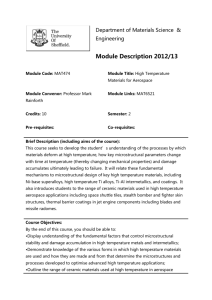403601.HOKSID-_MINERVA
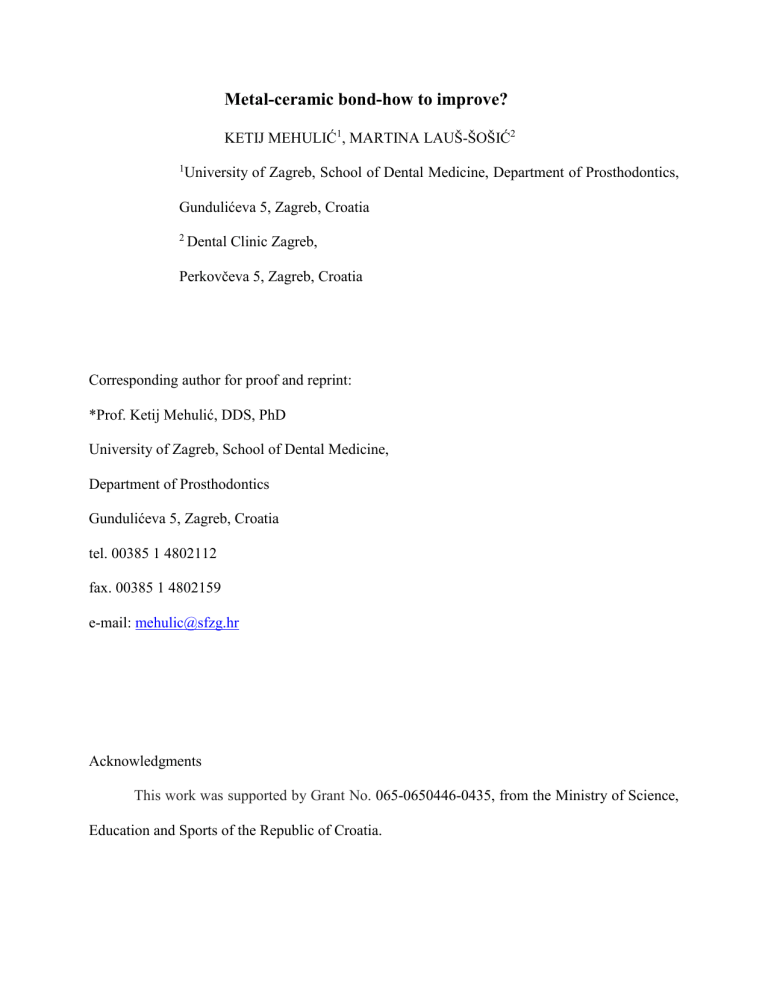
Metal-ceramic bond-how to improve?
KETIJ MEHULIĆ
1
, MARTINA LAUŠ-ŠOŠIĆ
2
1
University of Zagreb, School of Dental Medicine, Department of Prosthodontics,
Gundulićeva 5, Zagreb, Croatia
2
Dental Clinic Zagreb,
Perkovčeva 5, Zagreb, Croatia
Corresponding author for proof and reprint:
*Prof. Ketij Mehulić, DDS, PhD
University of Zagreb, School of Dental Medicine,
Department of Prosthodontics
Gundulićeva 5, Zagreb, Croatia tel. 00385 1 4802112 fax. 00385 1 4802159 e-mail: mehulic@sfzg.hr
Acknowledgments
This work was supported by Grant No. 065-0650446-0435, from the Ministry of Science,
Education and Sports of the Republic of Croatia.
Summary
Metal-ceramic restorations include the positive features of metal (strength, durability and stability) and ceramics (aesthetics). The strong bond on the metal-ceramic interface is the basic prerequisite for the durability of the metal-ceramic restoration. The heating of metal construction results in the diffusion of certain atoms (tracers) on the surface. There they react with atmospheric oxygen creating in oxides which remain on the cast surface, because the reversible diffusion is prevented. Atoms of silica in ceramic are bound with these oxides as a result of which a metal-tracer-ceramic compound is formed and a chemical bond is realised. In addition to forming an oxide layer, the oxidation heat treatment (OHT) is applied for all alloys in order to remove the entrapped gas and eliminate surface contaminants. Surface metal preparation before porcelain application may also affect the bond strength of metal and ceramics. Roughened surface by sandblasting enables mechanical interlocking and an increased surface for bonding metal and ceramics. Applying a bonding agent may improve the quality of the bond of certain metal-ceramic restorations. Due to the continued oxidation of titanium and creation of a nonadherent oxide layer, the bond strength between titanium and ceramics is weak, which is attempted to be resolved by firing in an argon atmosphere.
Key words: metal-ceramics, treatment of cast surface, oxidation heat treatment
1. Introduction
Metal-ceramic restorations are widely used in dental prosthetics. Characterized by greater strength, better bonds with metal construction and better aesthetic effect. In addition, they are bio-tolerant and resistant in the oral cavity area compared to conventional prosthodontic materials. However, they show certain limitations arising from the microstructure of the two different materials expected to behave as one after bonding. First of all, this relates to the brittleness of ceramics which breaks rather than deforms under load (as most of the constructed materials). The weak tensile, shear and impact strength of ceramics is partially redeemed by bonding to the cast metal framework. The adjustment of the coefficients of thermal expansion of the alloy and ceramics and the quality of the bond between the cast surface and ceramics now arise as dominant problems. The oxide layer on the surface of the cast represents an important factor in realising bond strength between the components.
1-3
The oxidation heat treatment may be deliberately performed before firing the ceramics or the alloy may oxidise during the firing cycle.
In any case, it is advisable that ceramics comes into contact with the oxide layer and not with the surface of the cast.
4,5
Studies of Brantley at al.
6
show that the formation of metal oxides during the oxidation process varies depending on the type of alloy, the method of surface finishing and the duration of the oxidation process itself.
2. Significance of the oxidation cycle with respect to metal-ceramic alloys
The complete performance of the oxidation heat treatment for gold alloys removes the organic material from the cast, stabilises the changes in alloy dimensions by reducing tension arising from uneven cooling in the investment material; the alloy is set in a metallurgic condition that will enable an even resistance when firing ceramics, it forms an oxide layer which supports the bonding of the cast surface and ceramics, but at the same time is responsible for the potential formation of bubbles in ceramics as a result of releasing gasses. Dent at al.
7
consider the use of a vacuum superfluous for the retraction of gasses from open surface communications to the surface of the cast, since the defects will be filled with air by vacuum interruption. The oxidation cycle of high-fusing gold alloys increases their hardness.
8
Ohno at al.
9
as well as Felten and Pettit
10
state that noble metal systems are characterised by the formation of a non-continuous oxide layer, which penetrates the alloy resulting in an effect of mechanical interlocking, which is the reason for the good adhesion of these systems.
The utilisation of base metal alloys in dental prosthetics increased during the past several decades, due to their low price and good mechanical features. Their weaknesses are potential biological risk and uncontrolled formation of chrome-oxide in the course of ceramics firing resulting in a weaker bond strength of these metal-ceramic restorations.
11,12
For these alloys the oxidation heat treatment (OHT) is used for removing entrapped gas, the elimination of surface contaminants and the formation of an oxide layer, 13 but it may also cause stresses potentially resulting in the distortion of the metal framework.
14,15
3. Oxide adherence to metal surface
There are different explanations for the interaction of oxide and ceramics in the course of firing. In 1959, King at al.
16
refuted the applied oxide layer theory, which states that ceramics wets the layer adhered to the metal, thus forming a transitional zone between the metal surface and ceramics. They believe that the layer of glass dissolves oxides on the cast surface, and that the layer of oxide-saturated glass bonds with the metal surface. The theory was in line with the difficulty of presenting the transitional zone on the interface between metal and ceramics. Pask and Fulrath
17
agree with the theory of direct bonding of ceramics on the cast surface allowing for the existence of a discrete oxide layer, which, if present, is bound to the cast. Although
Anusavice at al.
18
proved the accumulation of certain elements on the interface, their concentrations did not indicate the oxide layer with certainty, and they could have presented the solution of their ions in the interface ceramic. However, evidence of a discrete oxide layer on the interface were submitted by Miyagawa
19
in 1978 by using x-rays, crystalline SnO
2
and In
2
O
3
, arising during the de-gassing of gold alloys, they exist after the firing of ceramics, and therefore are not dissolved by glass. During the firing process, the oxide layer, created before the firing of ceramics, remains as a transitional zone between the metal and the glass.
The oxide adherence strength exceeding the cohesive strength of opaque porcelain is considered adequate for bonding ceramics.
20
According to Sced and McLean,
11
the type of failure is a significant indicator of the bond between metal and ceramics. Alloys classified as those that form a good bond with ceramic show wide areas with retained opaque porcelain, while those that form a weak bond are characterised by low or no remaining opaque porcelain after failure.
The adherence of oxide on the surface of the cast has been subject to research during the past 80 years, but no common viewpoint has been agreed as yet, thus representing the least known type of oxidation reaction. According to Stringer, 21 this includes not only the static situation such as
the relative surface energy of metal and oxide and Van der Waals interactions, but also the dynamic process of atom transfer across the interface, and the diffusion between metal and oxide.
The loss of oxide adherence during the oxidation process arises as a result of the accumulation of atom vacancies on the interface. Separation may arise during the first phase of oxidation, since the majority of vacancies arise at that time and the formation of oxides has only begun. Several theories exist on the improvement of adherence of oxide after adding oxygen-active elements
(yttrium, aluminium, and hafnium) or oxide dispersions (thorium) to alloys containing chromium.
22
A content of boron oxides that melt at the casting temperature provides chrome alloys with unique features in the course of melting and casting. The addition of aluminium and other oxygen-active elements to such an alloy has an opposite effect on such features as a result of their tendency to form "slag". Therefore, the absence of oxygen-active elements in chrome alloys with the content of boron is considered the most responsible for the loss of oxide adherence, since only the application of aluminium as a surface coating results in significant oxide adherence. Ringle at al.
23 and Mackert at al.
24 explain the mechanism of growth of chromium oxide as a result of the diffusion of the chromium ion through the oxide layer. The research of Mackert at al.
25
on Pd-Ag alloys proved that the oxidation of tin and indium arises more internally, and that ceramic is bound to the metallic nodules formed on the surface, primarily by mechanical interlocking.
In his research on surface oxides, with respect to 88% Au alloys Miyagawa 26 came to the following conclusion:
1) after the degassing process, non-precious elements in all alloys oxidise selectively;
2) there is significant formation of Fe
2
O
3
, In
2
O
3
and SnO
2
on the surface of the alloy to which only Fe, In or Sn were added;
3) in most cases, when two or more non-precious elements are added together, the stated oxides
are formed heterogeneously;
4) a quantity of formed oxides is not always in proportion with the quantity of additives
5) a parameters of oxide lattice depend on the concentration of added elements.
By examining the interface of the alloy containing a high percentage of palladium and ceramics,
Papazoglou at al.
27
show that the Proctol alloy (composition on percentages: Pd 75.2%, Ag 6.5%,
Au 6.0%, In 6.0%, Ga 6.0%, Ru <1.0%, Li <1.0%) forms an oxide layer. However, they also point out that the interface between metal and ceramics contains a certain transition from alloy to ceramics, without an obvious oxide layer. The stated area showed a higher concentration of Ga and In, without increasing the concentration of oxygen. The polished, etched and oxidised Proctol alloy again showed higher In and Ga oxide concentrations, which supports the fact that surface finishing affects the formation of oxides in the oxidation process. Palladium oxides dissociate at higher temperatures and thus the released oxygen may lead to the formation of bubbles on the metal-ceramic interface.
28
The use of a bond leads to the deposition of Sn at about 40 µm within the ceramic surface, but it also leads to the second phase of interaction on the ceramic layer and the formation of microleakage of 50-100 µm on the interface.
29
Hausselt
30
considers gold-rich bonding agent (Al 9%, Si
36%, K 10%, Au 29.4% and Zr 15.65%), responsible for interfacial stresses, which increases the compatibility of the alloy and ceramic. The presence of a bonding agent affects the metal-ceramic interaction depending on the type of system Al ions, 31 mainly originating from the bonding agent, diffuse more strongly through the interfacial zone, thus suppressing the diffusion of Cr, Ni, Co ions,
32
and residual stress is reduced through better adjustment of thermal coefficients.
33
Bonding agents form an aluminium coating, which entirely changes the type of proportion of oxides on the cast surface.
34
The gold-tone catalyst bonding agent and beryllium significantly increase the bonding strength.
35 Beryllium inhibits the excessive formation of chromium oxides and prevents
the formation of brittle nickel-chromium spinel increases the fluidity,
33
improves casting and controls the surface oxidation and bond strength.
29
The oxidation draws beryllium to the surface and increases the quantity of oxides. Air abrasion removes a part of the oxide layer, resulting in the formation of a surface including a significant portion of Al
2
O
3
. Susz and Meyer 36 believe that preliminary oxidation arises in Au-Pt alloys when surrounded by air, and if immersed into hot diluted sulphuric acid, this represents the best procedure before firing ceramics. Thus, a more homogenous concentration of indium is achieved on the cast surface, closer to the initial content, and the obtained bond strength is among the highest, showing least dispersion.
4. Preparation of the metal support surface
Surface finishing before the firing of ceramics may affect the bond of the two components.
37,38
Local irregularities such as rough angles, pits and holes may develop into spots of entrapped air and contaminants, which may cause the porosity of ceramics in the course of firing and develop into initial crack propagation spots. The surface finishing of casts using abrasive stones and carbide burs is conducted in one direction, since the grinding in various directions leads to drag projections of metal one above the other, resulting in entrapment of air, parts of abrasive and investment material.
39,40
The sandblasting of the cast surface removes furrows, flakes and overlaps resulting from the grinding process. Pask and Fulrath 17 believe that the sandblasted surface may contain a higher surface energy that allows increased wetting of metal in the course of applying ceramics. On the other hand, Hofstede at al.
41
proved that the direction of cast finishing does not have a significant impact on the number or the extent of porosity on the metal-ceramic interface or on the beam failure load, although sandblasting affects the increase of the load required for the stated failure. The utilisation of carbide burs in the polishing process results in less undercuts on the cast, while the application of carborundum points and disks creates more abrasive remains on the grinding surface.
42
The roughened surface may enable mechanical interlocking, increase the surface for metal and ceramics bonding
43
and it provides the highest bonding strength between metal and ceramics.
44
Sandblasting affects the formation of oxides, the oxide layer is different before and after the sandblasting procedure.
6
Aydin
45
achieves the best surface finishing of the Cr-Co alloy cast based on a systematic sequence by using hard stone, medium abrasive disks, second sandblasting, electro-polishing, hard rubber points, hard felt disks and soft brushes with polishing paste. Ibrahim
46
indicates a newly formed crystalline structure of Ni and Cr after sandblasting, thereby explaining the delamination of the oxide layer, the formation of NiO, Cr
2
O
3
, Fe
2
O
3
, as well as Si, K, Cl, Sn and
Cu on the ceramic part.
The optimum conditions for opaque porcelain techniques have not as yet been established. Rake at al.
47
believe that the bonding strength (base-metal alloy and Au-Pt-Pd alloys), when applying opaque porcelain on the oxidised surface, is significantly higher and that the two-layered application of opaque porcelain on the non-oxidised surface results in a significantly higher bonding strength. The weakest bonding is related to the directly tin-plated group, and the strongest to the tin-diffused group, controlled oxidation results in the strongest bonding strength, and the metal oxidation rate should approximate the ceramic vitrification rate. The diffusion rate of metal elements should be slower than vitrification in order to reach the highest metal ceramic bond strength.
48
Soldering is the standard laboratory procedure that could potentially affect the bonding strength and durability of the metal-ceramic restoration. Using the base-metal Ni-Cr alloy (Wiron
88) and solder (Wiron-Lot) and the 3-point bending test, Nikellis
49
concluded that adding solder to base-metal alloys does not affect the bond strength of metal-ceramics.
Literature states examples of research analysing the effect of changes in atmosphere during the process of ceramic firing to the bonding strength of metal-ceramic restorations. Using argon in palladium alloys, Wagner at al.
44
obtained lower values of bonding strength. Using Ni-
Cr alloys, Pask and Tomisia
50
concluded that vacuum firing leads to the formation of a thicker oxide layer on the metal-ceramic interface in relation to firing in argon. During the ceramic firing process of gold alloys, Leon and Fairhurst
51
use argon instead of a vacuum, thereby realising lower values of bonding strength. This is explained by the opposite effect of argon on the formation of oxides in alloys with a high percentage of gold.
5. Analysis of bonding strength of titanium alloys and aesthetic material
Recently, titanium has become more and more popular for several reasons - lower price, high strength, resistance to corrosion and bio-compatibility. Problems with titanium arise with its utilisation for metal-ceramic restorations due to a demanding casting process and realising a sufficient bonding strength between titanium and ceramics. In addition to cast titanium, there is also a technique of non-cast titanium (spark erosion) where titanium is scraped externally, and internally it erodes by a graphite electrode, whereby its tendency towards oxidation is decreased.
Due to the thermal expansion of titanium and the feature of forming a relatively thick nonadherent oxide layer at temperatures above 800°C, as a result of which the bonding strength is lowered, these metal-ceramic constructions require the use of certain types of ceramics.
52,53
The bonding strength of titanium and ceramics is lower by 33-60% [54], i.e. 38-58%
55
compared to
Ni-Cr alloys. Böning and Walter
56
emphasise the importance of removing the α layer for an optimum bonding of titanium and ceramics. Adachi at al.
57
believe that the lower bonding strength between titanium and ceramics originates from a weak bond between the oxide and metal, which is considered a result of the continuous oxidation of titanium. According to
Kimura
58
and Derand,
59
the non-adherent oxide layer represents the weakest bond between titanium and ceramics. By using argon for reducing the oxidation effect in titanium alloys, an improved bonding strength is achieved with respect to certain titanium-ceramic groups, which indicates only a secondary effect of argon. With titanium-ceramics, the use of a bonding agent or bonding porcelain results in better bonding features.
54
Mo
60
recommend sandblasting the surface of titanium alloys with Al
2
O
3 particles of 150-180 µm, as a way of achieving a better bond between ceramics and the titanium alloy. They consider the oxidation and the Si-couple agent coating of the titanium surface unnecessary.
6. Analysis of bonding strength when applying the “silicoater” procedure
As a classic method of chemical bonding, silicoater has been developed in 1984 and it is based on pyrolytic silica coating of the metal surface, whereas more recent methods are based on tribochemical silica-coating (Rocatec system) 62 Vallitu 63 believes that pyrolytic silica-coating with silane application provides the highest bond strength of dimethacrylate-based, fibrereinforced composite and pure titanium (31 MPa) and gold alloys (30 MPa). The mechanical roughening of the surface using air abrasion of Al
2
O
3
particles results in lower values of bonding strength (gold alloys: 17 MPa, titanium: 13 MPa) compared to chemical procedures of surface conditioning. Anagnostopoulos at al.
64 concluded that to the extent of surface oxidation, Ni-Cr alloys ensure more bonding sites for silanols compared to Au-Pd and Pd alloys, and that Ni-Cr alloys show the highest values of shear bond strength on smooth surfaces, regardless of the type of primer used, which is clinically applicable. For example, the reparation of the ceramic shell on the Ni-Cr alloy cast using active prepolymerised primers is more effective compared to twocomponent systems.
7. References
1 Anusavice KJ. Phillips` science of dental materials. 10th ed. Philadelphia: WB Saunders; 1996.
2 Wang CC, Hsu CS. The bonding mechanisms of base metals for metal-ceramic crown microstructure analysis of bonding agent and gold bond between porcelain and base materials.
Kaohsiung J Med Sci 1996;12:326-38.
3 McLean JW, Sced IR. Bonding of dental porcelain to metal II: The base metal alloy/porcelain bond. Trans J Br Ceram Soc 1973;72:235-8.
4 Borom MP, Pask JA. Role of ˝adherence oxides˝ in the development of chemical bonding at the glass-metal interfaces. J Am Ceram Soc 1966;49:1-6.
5 Mackert JR, Ringle RD, Parry EE, Evans AL, Fairhurst CW. The relationship between oxide adherence and porcelain-metal bonding. J Dent Res 1988;67:474-8.
6 Brantley WA, Cai Z, Papazoglou E, Mitchell JC, Kerber SJ, Mann GP, et al. X-ray diffraction studies of oxidized high-palladium alloys. Dent Mater 1996;12:333-41.
7 Dent RJ, Preston JD, Moffa JP, Caputo A. Effect of oxidation on ceramometal bond strength. J
Prosthet Dent 1982;47:59-62.
8 Leinfelder KF, O`Brien WJ, Fairhurst CW. Hardening of high-fusing gold alloys. J Dent Res
1966;45:392-6.
9 Ohno H, Kanzawa Y, Kawashima I, Shiokawa N. Structure of high-temperature oxidation zones of gold alloys for metal-porcelain bonding containing small amounts of In and Sn. J Dent
Res 1983;62:774-9.
10 Felten EJ, Petit FS. Development, growth and adhesion of Al
2
O
3
on platinum-aluminium alloys. Oxid Met 1976;10:189-223.
11 Sced IR, McLean JW. The strength of metal-ceramic bonds with base metals containig chromium: A preliminary report. Br Dent J 1972; 132:232-4.
12 Mackert JR, Fairhurst CW. SEM and EDXS characterization of adherent and non-adherent oxides. J Dent Res 1983;62:255.
13 McLean JW. The science and art of dental ceramics. Vol. 2. Chicago: Quintessence
Publishing Co.; 1980.
14 Yoshihiro T. Radiograph stress measurement of porcelain fused to metal. J Prosthet Dent
1984;52:349-52.
15 Bryant RA, Nicholls JI. Measurement of distortions in fixed partial dentures resulting from degassing. J Prosthet Dent 1979;42:515-20.
16 King BW, Tripp HP, Duckworth WH. Nature of adherence of porcelain enamels to metals. J
Am Ceram Soc 1959;42:504-25.
17 Pask JA, Fulrath RM. Fundamentals of glass to metal bonding VIII: Nature of wetting and adherence. J Am Ceram Soc 1962; 45:592-6.
18 Anusavice KJ, Ringle RD, Fairhurst CW. Bonding mechanism evidence in a ceramicnonprecious alloy system. J Biomed Mater Res 1977;11:701-9.
19 Miyagawa Y. X-ray diffraction at the metal-ceramic interface: Part 1: Commercial gold alloyporcelain interface. Nippon Dent Univ Annu Publ 1978;12:57-61.
20 DeHoff PH, Anusavice KJ, Hathcock PW. An evaluation of the four-point flexural test for metal-ceramic bond strength. J Dent Res 1982;61:1066-9.
21 Stringer J. Stress generation and adhesion in growing oxide scales. Werkst Korros
1972;23:747-55.
22 Mackert JR Jr, Parry EE, Hashinger DT, Fairhurst CW. Measurement of oxide adherence to
PFM alloys. J Dent Res 1984;63:1335-40.
23 Ringle RD, Fairhurst CW, Anusavice KJ. Microstructures in nonprecious alloys near porcelain-metal interaction zone. J Dent Res 1979;58:1987-93.
24 Mackert JR, Ringle RD, Fairhurst CW. Oxide wrinkling and porcelain adherence on nonprecious alloys. J Dent Res 1981;60:405.
25 Mackert JR Jr, Ringle RD, Fairhurst CW. High temperature behavior of a Pd-Ag alloy for porcelain. J Dent Res 1983;62:1229-35.
26 Miyagawa Y. X-ray diffraction at the metal-ceramic interface. Surface oxides of 88% Au alloys containing Fe, In, Sn for porcelain fusing. Shika Rikogaku Zasshi 1978;19:15-27.
27 Papazoglou E, Brantley WA, Mitchell JC, Cai Z, Carr AB. New high-palladium cast alloys: studies of the interface with porcelain. Int J Prosthodont 1996;9:315-22.
28 Carr AB, Brantley WA. New high palladium casting alloys: Part 1: Overview and initial studies. Int J Prosthodont 1991;4:265-75.
29 Hsu CS, Wang CC. The shear bond strength of porcelain and base metal alloys for metalceramic crown (VI). Kaohsiung J Med Sci 1997;13:721-9.
30 Hausselt JH. Improvement of porcelain-fused-to-metal compatibility by a new bonding agent.
J Dent Res 1982;61:330.
31 Anusavice KJ, Ringle RD, Fairhurst CW. Bonding mechanism evidence in a ceramicnonprecious alloy systems. J Biomed Mater Res 1977;11:701-9.
32 Anusavice KJ, Ringle RD, Fairhurst CW. Adherence controlling elements in metal-ceramic systems II: Nonprecious alloys. J Dent Res 1977;56:1053-61.
33 McLean JW, editor. Dental Ceramics: Proceedings of the First International Symposium on
Ceramics. Chicago: Quintessence Publishing Co, Inc;1983.
34 McLean JW. The search for improved metal-ceramics. Quintessence Dent Technol.
1978;2:51-9.
35 Wu Y, Moser JB, Jameson LM, Malone WF. The effect of oxidation heat treatment on porcelain bond strength in selected base metal alloys. J Prosthet Dent 1991;66:439-44.
36 Susz CP, Meyer JM, Payan J, Stoian M, Sanchez J. Effect of treatments preceding porcelain baking on the strength of the ceramic-metal bond. SSO Schweiz Monatsschr Zahnheilkd
1980;90:393-404.
37 Miller LL. Framework design in ceramo-metal restorations. Dent Clin North Am
1977;21:699-716.
38 Riley EJ. Ceramo-metal restoration: state of the science. Dent Clin North Am 1977;21:669-82.
39 Campbell SD, Sirakian A, Pelletier LB, Giordano RA. Effects of firing cycle and surface finishing on distortion of metal ceramic castings. J Prosthet Dent 1995;74:476-81.
40 Dykema RW, Goodacre CJ, Phillips RW. Johnston`s modern practice in fixed prosthodontics.
4th ed. Philadelphia: WB Saunders; 1986.
41 Hofstede TM, Ercoli C, Graser GN, Tallents RH, Moss ME, Zero DT. Influence of metal surface finishing on porcelain porosity and beam failure loads at the metal-ceramic interface. J
Prosthet Dent 2000;84:309-17.
42 Wu YT, Hsu CS. The shear bond strength of porcelain and base alloys for metal-ceramic crown the study of metal roughness and microstructure. Kaohsiung J Med Sci 1996;12:728-36.
43 McLean JW, Sced IR. The bonded alumina crown 1: The bonding of platinum to aluminous dental porcelain using tin oxide coatings. Aust Dent J 1976;21:119-27.
44 Wagner WC, Asgar K, Bigelow WC, Flinn RA. Effect of interfacial variables on metalporcelain bonding. J Bomed Mater Res 1993;27:531-7.
45 Aydin AK. Evaluation of finishing and polishing techniques on surface roughness of chromium-cobalt castings. J Prosthet Dent 1991;65:763-7.
46 Ibrahim RM. Scanning and electron microprobe analysis of metal-porcelain interface. Egypt
Dent J 1995;41:1469-78.
47 Rake PC, Goodacre CJ, Moore BK, Munoz CA. Effect of two opaquing techniques and two metal surface conditions on metal-ceramic bond strength. J Prosthet Dent 1995;74:8-17.
48 Deger S, Caniklioglu MB. Effects of tin plating on base metal alloy-ceramic bond strength. Int
J Prosthodont 1998;11:165-72.
49 Nikellis I, Levi A, Zinelis S. Effect of soldering on the metal-ceramic bond strength of an Ni-
Cr base alloy. J Prosthet Dent 2005;94:435-9.
50 Pask JA, Tomsia AP. Oxidation and ceramic coatings on 80Ni20Cr alloys. J Dent Res
1988;9:1164-71.
51 Leone EF, Fairhurst CW. Bond strength and mechanical properties of dental porcelain enamels. J Prosthet Dent 1967;18:155-9.
52 Hautaniemi JA, Hero H, Juhanoja JT. On the bonding of porcelain on titanium. J Mater Sci
1992;3:186-91
53 Warpeha WS Jr, Goodkind RJ. Design and technique variables affecting fracture resistance of metal-ceramic restorations. J Prosthet Dent 1976;35:291-8.
54 Atsü S, Berksun S. Bond strength of three porcelains to two forms of titanium using two firing atmosphere. J Prosthet Dent 2000;84:567-74.
55 Probster L, Maiwald U, Weber H. Three-point bending strength of ceramics fused to cast titanium. Eur J Oral Sci 1996;104:313-9.
56 Böning K, Walter M. Metall-Keramik-Verbund von gegossenem Titan. Dtsch Zahnärztl Z
1991;46:750-3.
57 Adachi M, Mackert JR Jr, Parry EE, Fairhurst CW. Oxide adherence and porcelain bonding to titanium Ti-6Al-4V alloy. J Dent Res 1990;69:1230-5.
58 Kimura H, Horng C, Okazaki M, Takahashi J. Thermal compatibility of titanium-porcelain system. J Osaka Univ Dent Sch 1990;30:43-52.
59 Derand T, Hero H. Bond strength of porcelain on cast vs. wrought titanium. Scand J Dent Res
1992;100:184-8.
60 Mo A, Cen Y, Liao Y. The influence of surface conditioning on the shear bond strength of La-
Porcelain and titanium. Hua Xi Kou Qiang Yi Xue Za Zhi 2003;21:104-6.
61 Tiller HJ, Gobel R, Magnus B, Musil R, Garschke A, Lockowandt P et al. Sandstrahlprozess and seine Einwirkung auf den Oberflächenzustand von Dentallegierungen II. Quintessenz
1985;36:2151-8.
62 Guggenberger R. Rocatec System Haftung durch tribokemische Besichtung. Dtsch Zahnärztl
Z 1989;44:874-6.
63 Vallittu PK, Kurunmäki H. Bond strength of fibre-reinforced composite to the metal surface. J
Oral Rehabil 2003;30:887-92.
64 Anagnostopoulos T, Eliades G, Palaghias G. Composition, reactivity and surface interactions of three dental silane primers. Dent Mater 1993;9:182-90.

